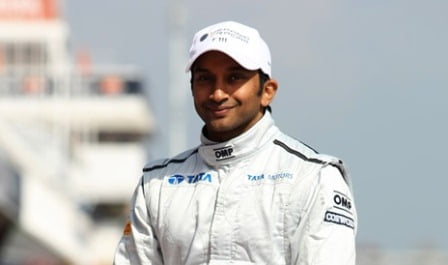Ferrari’s President Luca di Montezemolo made a statement in Abu Dhabi in favour of the manufacturer teams running three cars in the near future. His statement didn’t find much support from the other Team Principals in the Formula1 Paddock, but somehow I believe that what he said does make some sense.
His logic sounds simple. The three new teams that joined the sport at the start of the 2010 season haven’t really performed as per anyone’s expectations. Team Lotus, Virgin Racing and Hispania Racing Team have been off-the-pace in pretty much all sessions held till date. They have also been outside the points and barring Team Lotus, the progress of the other teams hasn’t been too visible this season. In order to boost their performances in the coming season Virgin and HRT have entered into tie-ups with other technically stronger teams.
Read post: Marussia Virgin Racing Tie-Up With Mclaren While HRT Do So With WilliamsF1
This is where I would agree with Luca’s statement. Let the top teams like Ferrari, Mclaren, Red Bull Racing, etc. run three car teams, where the third car is actually run by a privateer team. This somewhat indicates a reference to ‘customer’ teams, which have been banned in Formula1 since a few seasons.
However, does Luca’s opinion make sense? I would say, yes! The current ‘customer’ status limits the non-manufacturer teams to purchase of engines, gearboxes and KERS systems from the manufacturers. However, the chassis, suspension, aero package and everything else need to be ‘manufactured’ by the teams themselves and hence the granted ‘constructor’ status in the sport.
While the current arrangement seems fair, it also means that the mid-and-bottom field teams have to find their way to build an efficient and quick racing car, which in the modern Formula1 era is directly proportional to the amount of money a team can spend (well almost)! The end result typically is a team with a mediocre budget building an averagely quick car that laps a few seconds off the front runners pace. Good for the team? No! Good for the sport and the fans? No! Good for the team’s sponsors? Hell No! This is exactly what Luca seems to be questioning as well.
Imagine a scenario where there are multiple Ferraris, Mercedes and other top team cars on the grid, all in different livery, since they belong to different teams. However, each car is as quick as the other and we have a competitive grid of 24 cars with the ‘privateer’ teams only having to bother about their drivers, sponsorship, marketing and merchandise sales since the technical operations and updates are taken care of by their ‘supplier’ teams. This scenario would also mean that the entire grid would be bunched up by a second or little more and even the privateer team drivers could boast of world-class equipment (or rather not complain about the lack of it!).
What Luca stated isn’t new to the sport. Infact, early days of Formula1 saw ‘customer’ teams thrive on-track and often beat the manufacturer teams. Similar arrangements are followed in MotoGP, Le Mans and other globally renowned racing series. A step backwards for the sport might just help improve the show which everyone has been complaining of. Any improvement of action on track will benefit all stakeholders in Formula1 – FOM, FIA, FOTA, teams, drivers, sponsors, TV broadcaster and of course the fans!
Yes, Luca’s suggestion does have a downside to it, which Bernie also brought up in Abu Dhabi. Should one or two teams decide to leave the sport, suddenly we could have a gap of 6 or more cars. However, Bernie also mentioned (quite cheekily) to Autosport that ‘If by chance we lost a couple of teams then I think it will probably be good’, which also means that Luca’s idea isn’t a bad one altogether.
My point is quite simple as well. Very rarely do we see privateer teams come forward and challenge the manufacturer teams on a consistent basis. We had Williams do so in the 90s and now have Red Bull Racing, but traditionally and in the recent past the manufacturer teams have dominated the sport. Much of this is due to the financial might that they are able to gather from their parent brands and sponsors which has allowed them to invest in world-class infrastructure and the best of team personnel.
Also, in my opinion, manufacturing a quick racing car is not always going to be a private team’s area of expertise and they will more often than not be playing catch up. Why not leave the complex manufacturing stuff to the experts (read manufacturers) and just focus on building a world-class racing team brand for yourself which is also commercially viable. Food for thought?














5 comments On The Big Confusion About Three Car Teams In Formula1 And Why I Am In Favour
I like the idea of having Le Mans tpye racing, but why would a manufacturer team allow their car to be branded by someone else? They don’t need the money. And they certainly don’t want the competition.
It’s a bit like a fantasy Chinese iPhone replica. Apple licenses the original iPhone and (say) Micromaxx sells it on their name at a similar price. WTF??
The rich (and original) teams pay for research and development and manufacturing and then you bring in a suit with an MBA in Marketing who makes money on it. Totally unfair.
Thanks Sahil. Well, manufacturers do want the money and hence are currently selling engines, gearboxes and KERS systems to teams. Would they want to sell a car to the other teams? I am sure they would, they have done so in the past. As for competition, yes, the field will be closer, but ultimately, for the sport we need wheel-to-wheel racing. The lower rung teams will of course find it difficult to build as competitive cars if not more competitive.
F1 teams are looking to get more commercially viable. By having cars as quick as the top of the field, this will help their sponsors and media as well. Even more so, teams can finally have a sight of getting commercially successful as well. Give it a deeper thought!
We have seen it in 2007 and 08 that when the grid is mighty competitive its always the big 2 that seem to have the edge so what’s the difference if u put three cars or two cars? ferrari mclaren and redbull are always gonna have a upperhand
Well, i see improved money generation aspect for top teams and the lower teams brands levitated in an international scenario leading to more money flow into the sport. However buying cars from top teams would literally shut down considerable percentage of business in the engineering industry. Example if we consider team lotus and virgin based in oxford and yorkshire use wind tunnels and test rigs located around their bases. These wind tunnels may have no relationship with the big teams as the big teams can afford their own wind tunnels and test rigs. If the call for new rules about top teams selling their cars, those businesses reliant on the small f1 teams might lose their main customers. hence such new rules can damage some critical businesses of the engineering industry.
Yes Dinesh this is the downside of this regulation should it be changed. I agree with your view but having said that one would need to take harsh calls when the sport is in jeopardy.